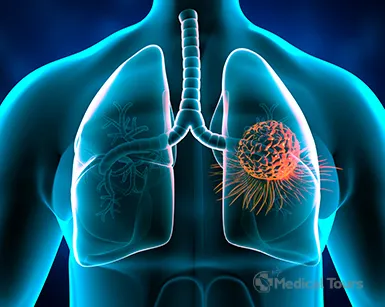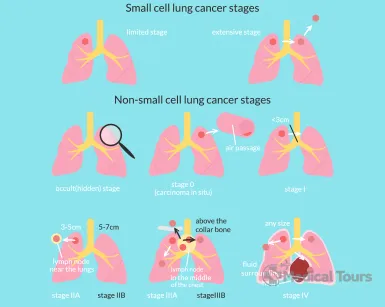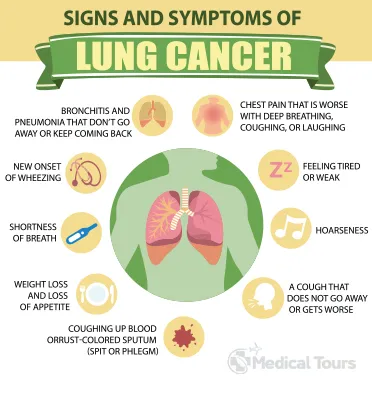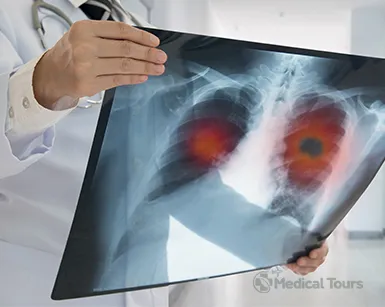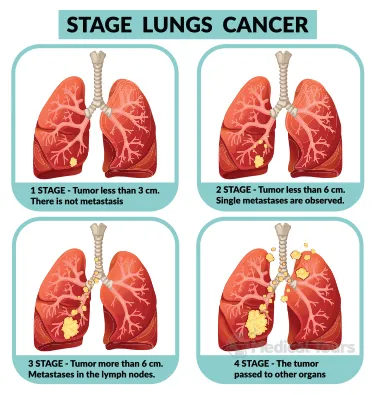The cost of a lung cancer cure in India starts from 500 USD (37550 INR). This data will help one determine the best-suited treatment plan to make sure there are positive outcomes.
The cost for a PET scan in India ranges from USD 306 – 348 (22980 – 26134 INR). Lung cancer surgery in India costs between 3500 – 7000 USD (262850 – 525700 INR) depending on the chosen procedure, the chosen specialist, and the cancer treatment facility chosen. Chemotherapy is the most common method and is generally combined with other treatment modalities to ensure a complete cure. One cycle of chemotherapy costs between 500 – 1000 USD (37550 – 75100 INR). The cost for radiation therapy is 3500 – 5500 USD (262850 – 413050 INR). The cost for radiosurgery is 5000 – 10000 USD (375500 – 751000 INR).
Types Of Lungs Cancer
Lung cancer is a disease in which abnormal cells in the lungs grow and reproduce quickly. There are two main types, small cell lung cancers (SCLC) and non-small cell lung cancers (NSCLC). This classification is based on the appearance of tumour cells under a microscope.
Small Cell Lung Cancer (SCLC)
Also called Oat cell carcinoma is a rare type of lung cancer. It accounts for 10-15% of all types of lung cancer. It is very different in appearance under the microscope than other lung cancers, which can make it hard to diagnose. It is fast-developing lung cancer that may spread very quickly.
Non-Small Cell Lung Cancer (NSCLC)
It is the most common type of lung cancer. It accounts for 85% of all cases. NSCLC is divided into three types, based on the cells found in the tumor: adenocarcinoma, squamous cell carcinoma, and large-cell carcinoma.
In this type of cancer, the main subtypes include:
- Adenocarcinoma: It is the most common type of lung cancer in non-smokers. It starts in cells that release mucus, which builds up and blocks airflow. Adenocarcinoma begins in the parts of the lungs that are closest to the outside.
- Squamous cell carcinoma: Squamous cell carcinoma starts with flat squamous cells thin cells that look like fish scales. They tend to affect smokers. The disease affects the outermost layer of skin and is often found on the arms, legs, face, and neck.
- Large cell carcinoma (undifferentiated): A large-cell carcinoma is a type of lung cancer that involves cancer cells that are larger than other types of non-small cell carcinoma. It rarely spread to other parts of the body through the lymphatic system or blood vessels, although it can metastasize outside the lungs.
Apart from the above-mentioned other types of lung cancer includes:
- Lung carcinoids: Lung carcinoids make up less than 5% of lung tumors. The majority grow slowly and are considered non-small cell lung cancer. Instead of rapidly dividing cells, carcinoids start small, then multiply very slowly, and eventually invade nearby tissues. They can grow into blood vessels or other parts of the lung in addition to the main tumor.
- Other lung tumors: Adenoid cystic carcinoma, lymphoma, and sarcoma are categorized as other types of lung cancer.
- Cancer that spread to the lungs: Cancers that start with other organs can sometimes spread to the lungs. Treating metastatic lung cancer depends on where it began (the primary cancer site). Therapy for cancer that started in another part of the body is based on what part of the body was affected by the cancer cells.
Signs And Symptoms of Lung Cancer
Sometimes lung cancer causes no symptoms until it has spread to other parts of the body. But some symptoms in the early stages are easy to recognize and should be looked into as soon as possible.
Listed below are some of the symptoms of lung cancer:
- Hoarseness.
- Wheezing.
- Decreased appetite.
- Running out of breath.
- Feeling exhausted or weak.
- Weight loss is unexplainable.
- Non-disappearable cough or worsens.
- Blood spit or rusty-colored spit (spit or phlegm).
- The chest pain often worsens with deep respiration, cough, or laughter.
- Infections like bronchitis and pneumonia do not disappear or continue to return.
If lung cancer extends to other areas of the body, it can result in serious symptoms and complications such as:
- Yellowish skin and eyes.
- Bone pain (for example, back or hip pain).
- Certain lung cancers may cause syndromes, which are specific symptom groups.
- Enlarged lymph nodes (accumulation of immune system cells) such as those in the neck or above the collarbone.
- Changes in the nervous system (headache, weakness or numbness of an arm or leg, dizziness, balance problems, or convulsions), from cancer to the brain.
Causes Of Lung Cancer
Identification of specific risk factors for lung cancer can allow you to take action against the illness. A variety of factors can cause lung cancer. There are some the risk factors but they are not limited such as:
- Smoking.
- Past radiotherapy.
- Exposure to 2nd-hand smoke.
- Family history of lung carcinoma.
- Exposure to asbestos or other cancer-causing substances.
- Exposure to radon (Radon is a naturally occurring radioactive gas that can cause lung cancer) emissions.
Diagnosis And Tests of Lung Cancer
If you are being treated for lung cancer, your doctor will closely monitor the disease and may suggest some tests to look for cancerous cells and rule out other possibilities. Based on this information, your doctor may suggest a series of tests to look for cancerous cells and rule out other possibilities.
It can be diagnosed in the following ways:
- Imaging Test: An x-ray is a common imaging test that helps diagnose medical conditions. In this, an abnormal nodule or mass can be easily detected through an x-ray image of the lungs. Small lesions can also be detected while performing an x-ray. Even with a CT scan, small lesions may be revealed in your lungs that may not be detected by radiography.
- Sputum Cytology: Lung cancer cells are easily detectable by examining the spectrum under the microscope. If you have a cough and produce sputum, watching sputum under the microscope may sometimes reveal the presence of lung cancer cells.
- Tissue sample biopsy: A biopsy process is used to examine an abnormal cell sample and diagnose cancer. The biopsy can be performed in several ways including bronchoscopy. In bronchoscopy, a light tube is passed down through the throat into the lungs to examine abnormal areas. Mediastinoscopy is also another biopsy procedure in which tissue samples are taken from lymph nodes by making an incision at the base of the neck and then inserting surgical tools from behind the breastbone. Needle biopsy is used for collecting suspicious cells from chest imaging or X-ray that guide a needle from the chest into lung tissue.
Stages Of Lung Cancer
![Lung Cancer Stage Lung Cancer Stage]()
There are various treatments for lung cancer. The treatments depend on the stage of the disease and may include surgery, chemotherapy, radiation therapy, or stem cell transplantation. In some cases, your treatment team may suggest participation in clinical trials which test new treatments or offer hope for better options in the future.
The stage of cancer is the most important factor in deciding which treatment will be used. Various stages of lung cancer are as follows:
Stage 1
You will be given an anticancer medication to kill cancer cells. Surgery is done to remove all the cancer cells from your lungs and adjoining lymph nodes. Doctors may recommend chemotherapy after surgery to make sure that you are cancer-free.
Stage 2
While the treatment for stage 2 lung cancer is very similar to that for stage 1, there are some differences. Radiation therapy and chemotherapy may be used to shrink cancer before surgery, which may help improve the chances of removing all the cancerous tissue from your lungs.
Stage 3
There are many ways to treat stage 3 lung cancer. Surgery may be followed by chemotherapy and immunotherapy. Sometimes targeted therapy is recommended. Your doctor will help you decide what treatment is best for you.
Stage 4
Although it is difficult to reverse advanced lung cancer, there are some medicines you can use to manage your symptoms. Talk to your doctor about what is best for you.
Treatment By Stage for Small Cell Lung Cancer
The treatment for small cell lung cancer is likely to start with chemotherapy and then radiotherapy, or chemoradiation. People who are fairly fit may have chemotherapy and radiotherapy at the same time. It is quite common for this type of cancer to spread to the brain. So doctors often recommend radiotherapy to the brain for people whose lung cancer shrinks with chemotherapy treatment.
Some stage I lung cancers have surgery to remove the part of the lung containing the tumor (a lobectomy). The surgery is followed by chemotherapy and sometimes radiotherapy. But usually at this stage, cancer has already spread and surgery cannot be performed.
If you have advanced small cell lung cancer that has spread to lymph nodes or other areas of the body you may be offered chemotherapy, radiotherapy, or treatment to relieve symptoms. Chemotherapy and radiotherapy can be given in addition to each other.
Treatment By Stage for Non-Small Cell Lung Cancer
In this type of cancer, the cure is divided into 4 stages:
Stage 1
If surgery is not possible, radiofrequency ablation (RFA) may be suggested. This involves inserting a needle with a wire inside it as close as possible to the tumour. Once in position, the wire is heated to destroy the cancer cells. RFA could also be used to treat any lymph nodes near the main tumour which might contain cancer cells too small to see on scans or biopsies.
Stage 2
For stage 2 non-small cell lung cancer, depending on the position of the tumour, the patient may be offered surgery to remove part of the lung (a lobectomy) or all of the lung (a pneumonectomy). This is known as an operation. If this cannot prevent cancer from coming back, chemotherapy may be needed afterward. In other cases, radiotherapy may be given.
Stage 3
For stage 3 non-small cell lung cancer surgery may still be possible, depending on where the cancer is in the lung. You may then have chemotherapy to try to lower the risk of cancer coming back. If we find cancer cells in the lymph nodes during surgery (lymphadenectomy) most likely chemotherapy and possibly radiotherapy may be required after the operation.
The treatment depends on how advanced the cancer is and how much it has spread. If the scans showed that the cancer cells were located in the middle area of the chest (the mediastinum), surgery may be offered instead of primary radiotherapy. However, if a tumour is very close to the heart or if there are lymph nodes on the opposite side of your chest, surgery is not possible and chemotherapy will be recommended. Depending on which organs are affected by more advanced cancer, you may need to undergo chemotherapy followed by radiotherapy.
Stage 4
Treatment for stage 4 non-small cell lung cancer aims to control cancer for as long as possible and to shrink the tumor down to reduce symptoms. Chemotherapy (chemo) uses anti-cancer drugs that are usually taken by mouth or given by injection. The drugs can destroy the cells in many types of cancer, including lung cancer, but they can also damage healthy cells in the body. Biological therapy drugs work in different ways than chemotherapy to attack cancer cells.
Treatment Options for Lung Cancer
When it comes to lung cancer treatment, several treatments are available depending on the stage of cancer, personal characteristics, and health status. The treatment of lung cancer depends on its type and how far it has spread. Surgery, chemotherapy, radiation therapy, or targeted therapy may be used to treat non-small cell lung cancer. Small cell lung cancer usually receives radiation therapy and chemotherapy. Various treatments for lung cancer include:
Stereotactic body radiation therapy
Minimally Invasion Surgery
Surgery
Surgery is one of the oldest and most effective ways of treating lung cancer. As the name suggests, this type of surgery is used to treat early-stage lung cancer. The procedure involves removing all cancerous tissue from the lungs as well as lymph nodes that may be present in the chest cavity. Palliative surgery, on the other hand, is performed only when your life expectancy is less than a year and that you are not responding well to treatment.
Here are some of the most common surgical interventions for removing lung cancer:
- Wedge resection is usually a common surgery to remove lung cancer from the patient. This surgery removes a small part of the lung, along with some healthy tissues to ensure that no traces of cancer are left behind.
- Segmental resection involves the removal of a larger section of lung tissue, which helps to improve breathing if you have certain types of lung cancer.
- A lobectomy is the process of removing an entire lung lobe. Pneumonectomy describes a similar operation in which both lungs are removed, though the latter is rarely performed due to its risks and severe nature of the operation.
Radiation Therapy
Radiotherapy can help alleviate symptoms and reduce the growth of lung cancer tumours. Radiotherapy uses high-power energy beams such as X-rays or protons to kill cancer cells in the body. It is also useful for advanced lung cancers, radiotherapy may help alleviate symptoms, such as pain.
Chemotherapy
Chemotherapy is a type of treatment that uses strong medications to kill cancer cells. It is usually used along with other types of radiation, such as surgery or radiation therapy, to get rid of cancer cells that may have stayed after surgery or radiation therapy.
Stereotactic body radiation therapy
Stereotactic body radiation therapy, also known as radiosurgery, is a type of radiation treatment that uses multiple radiation beams to target cancer. These beams are carefully placed on your body from many angles, so they target the tumor while leaving surrounding tissues unharmed.
Targeted drug therapy
Radiation therapy is sometimes used as a surgical adjuvant but can be used as the primary treatment option. It is a logical choice for primary lesions requiring difficult or extensive surgery (e.g., eyelids, nose, and ears). This modality can also be used to treat recurrences after a primary surgical approach.
Immunotherapy
Targeted medication treatments focus on certain abnormalities in cancer cells. By blocking these abnormalities, targeted medication treatments can cause the death of cancer cells. This can help your body fight cancer more effectively.
Palliative Care
Palliative care is a process that involves working with a physician, other health professionals, and members of the palliative care team to minimize your symptoms and improve the quality of your life.
Minimally Invasion Surgery
Minimally invasive surgical techniques have been developed to diagnose and treat lung cancer. These procedures are performed with the use of a video camera that is inserted through a small 3-inch incision of the chest. This enables the surgeon to see the tissue being operated on without having to make a large incision in the chest and spreading the ribs. The minimally invasive technique can provide a more accurate surgery with less recovery time, less risk of infection, less bleeding, and less discomfort than the traditional procedure.
CyberKnife Radiosurgery
Cyberknife is the world's most advanced technology to treat tumors with pinpoint accuracy and precisely deliver treatment to the tumor alone, sparing surrounding healthy tissue. CyberKnife is a non-invasive, high-energy radiation treatment that delivers very precise beams of radiation from many angles outside the body. The accuracy of Cyberknife is so precise that radiation can be 'matched' to the shape of small complex tumors, even those located near critical organs. This ability allows Cyberknife to treat many lesions including some considered inoperable or untreatable with surgery.
Survival Rate for Lung Cancer in India
Over the last ten years, lung cancer treatment in India has come a long way from being a complex and stressful procedure to a stress-free process that is highly convenient for patients. The survival rate of lung cancer treatment in India is 60-65% for patients with localized cancer, and 40-50% if the cancer is at an advanced stage. This is not to say that every lung cancer patient will benefit from the same percentage of improvement as every patient's case is unique.
Cities Offering the Best Treatment for Lung Cancer in India
If you have been diagnosed with cancer, it is important to ensure that you get the best treatment at an affordable price. The first step should be to consult with a specialist who can help you understand your options and make recommendations based on your specific case. India thereby provides various facilities including Globally Trained & Highly Experienced Lung Cancer Specialists, the World’s Lowest Cost Cancer Treatment Packages, Complete Cancer Care, and a team of world-class health professionals, pioneers in their field, who will provide the best treatment options for your lung cancer. Even India provides personalized targeted therapy which is seen as a new generation for lung cancer treatment.
Recommended hospitals for lung cancer in India areas:
- Apollo Hospital
- Fortis
- Max Health Care
- Artemis
- Manipal Hospital
- BLK Super Speciality Hospital
- Medanta
- Asian Heart
- Narayana Health
Major cities providing expert opinions from top doctors at the best hospitals are:
- New Delhi
- Mumbai
- Bangalore
- Hyderabad
- Pune
- Mohali
FAQs
Lung cancer treatment cost in India depends on several factors. The city you choose to get your treatment and the clinic or the hospital where you get your treatment have a huge impact on the cost of your treatment. The experience, skill, and expertise of the surgeon and his team performing your treatment are also significant factors that affect lung cancer treatment costs in India.
The average lung cancer treatment cost in Delhi is likely to start from INR 2 to, 00,000 and go up to INR 8, 00,000. The cost depends on several factors such as the clinic or the hospital where you get your treatment and the extent of your disease.
A new study revealed that resolvin is a natural compound secreted by our body to stop the inflammatory reaction. The study also found that it may prevent the formation of tumors when such growth is induced by cellular waste.
Surgical removal of the tumor and a biopsy are the first steps in diagnosing lung cancer. If surgery is not an option, a combination of chemotherapy and radiation can be your primary treatment. In advanced lung cancers, radiotherapy can help reduce pain.
The treatment of lung cancer varies from person to person, depending on their overall health and the stage of the disease. If you are reasonably healthy and have a type of early lung cancer, chemotherapy (chemotherapy) combined with radiotherapy (known as chemotherapy) may help you to be cured. Some people may even be healed as a result of this treatment.
The number of cycles of treatment you will have depends on why you are having chemotherapy. Most people have 4 to 8 cycles, but you may have more or less depending on your health and what type of cancer you have.
The main risk factors include smoking and drinking which could be controllable.
There are basically 3 types of diagnosis:
- Primary: Includes X-rays, CT scans, etc.
- Secondary: Includes Bronchoscopy, EBUS (Endobronchial Ultrasound), or CT-guided biopsy.
- Advanced: Includes PET CT whole body, MRI, Mediastinoscopy, and other surgical procedures.
Cancer in stages 2/3 is confined to the chest.
Carcinoid tumor is a rare type of lung cancer. This cancer can also spread to other parts of the body, and it can affect many organs in your body. Other types of cancer include soft tissue sarcomas, which can also appear in the lungs after spreading from other parts of your body.
